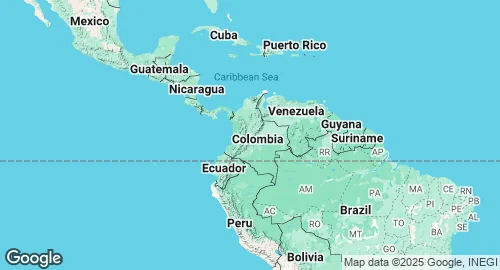Colombia Military Forces 🇨🇴
Military Strength Overview
| 🛩️ Air Force | 434 active aircraft |
| ⚓️ Naval forces |
237 ships in fleet
– incl. 4 submarines |
| 🪖 Active Troops | 257,450 personnels |
| ⛑️ Reserve Troops | 34,950 personnels |
| 👮♀️ Paramilitary | 165,050 personnels |
Defense Statistics & Key Metrics
| Population | 52.3 million (2023) |
| GDP | $363.5 billion (2023) |
| GDP per capita | $6947 (2023) |
| Military Budget | $15.1 billion (2024) |
| Share of GDP in Milex | 3.4% (2024) |
| Share of Govt Expenditures | 10.1% (2024) |
| Military spends per capita | $287 (2024) |
| Inflation Rate | 6.61% (2024) |
| Military Personnel | 428,000 (2020) |
Strategic Overview in 2025
Decades of counter-insurgency warfare have forged Colombia's military into one of Latin America's most experienced and professional forces. However, the 2016 peace accord with the FARC has precipitated a strategic shift, compelling the armed forces to adapt from a singular focus on internal conflict to a broader set of challenges, including conventional deterrence, border security, and transnational crime. This transition is occurring amidst persistent threats from FARC dissidents, the ELN insurgency, and powerful criminal organizations.
Military Forces and Capabilities
The Colombian military is one of the largest in the region, with a primary emphasis on its land forces. The Army is battle-hardened, with extensive experience in jungle and mountain warfare, and possesses a significant number of special forces and rapid deployment units. The Air Force and Navy play crucial supporting roles, particularly in surveillance, mobility, and riverine operations, which are vital for controlling Colombia's challenging geography.
Equipment is a mix of US, Israeli, European, and Brazilian hardware. While proficient in counter-insurgency operations, Colombia has historically lacked robust conventional capabilities. Recent modernization efforts aim to address this gap. Key acquisitions include the expected purchase of Swedish Saab 39 Gripen fighters to replace aging Kfir jets, and the procurement of Israeli Barak MX air defense systems, a significant upgrade to its defensive posture. The armed forces are also expanding their drone capabilities through a partnership with Spain to co-develop the Atlante II UAV, and are upgrading their M1117 armored vehicles.
Defense Industry and Future Trends
Colombia possesses a nascent defense industry, with state-owned companies like INDUMIL, COTECMAR, and CIAC producing small arms, ammunition, and light naval vessels. The government's "Fuerza Innovación" initiative is a strategic push to foster domestic innovation in dual-use technologies, including AI and cybersecurity, to reduce dependency on foreign suppliers. A significant area of development is in UAVs, with Colombia aiming to become a regional leader in this technology. Despite these ambitions, the country will continue to rely on foreign partners for advanced weapons systems for the foreseeable future. A key challenge is the defense budget, a large portion of which is consumed by operational costs and pensions, leaving a relatively small amount for new acquisitions.
Colombian Military Budget History
Population and Military Personnel Trends
GDP and Inflation Rate Trends
Colombian Naval Shipbuilding
| Class | Type |
|---|---|
| Almirante Padilla | Missile frigate |
Military Expenditure: SIPRI Milex.
